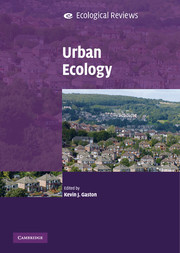Book contents
- Frontmatter
- Contents
- List of contributors
- Preface
- 1 Urban ecology
- 2 Urbanisation
- 3 Urban environments and ecosystem functions
- 4 Individual species and urbanisation
- 5 Species diversity and urbanisation: patterns, drivers and implications
- 6 Urbanisation and alien invasion
- 7 Interactions between people and nature in urban environments
- 8 Urban ecology and human social organisation
- 9 Urban ecology and human health and wellbeing
- 10 Bringing cities alive: the importance of urban green spaces for people and biodiversity
- 11 Integrating nature values in urban planning and design
- 12 Urban futures
- Index
- References
6 - Urbanisation and alien invasion
Published online by Cambridge University Press: 05 June 2012
- Frontmatter
- Contents
- List of contributors
- Preface
- 1 Urban ecology
- 2 Urbanisation
- 3 Urban environments and ecosystem functions
- 4 Individual species and urbanisation
- 5 Species diversity and urbanisation: patterns, drivers and implications
- 6 Urbanisation and alien invasion
- 7 Interactions between people and nature in urban environments
- 8 Urban ecology and human social organisation
- 9 Urban ecology and human health and wellbeing
- 10 Bringing cities alive: the importance of urban green spaces for people and biodiversity
- 11 Integrating nature values in urban planning and design
- 12 Urban futures
- Index
- References
Summary
Introduction
Urbanisation is a rapidly developing process of global change. The world's human population in 1900 was around 1.6 billion, of which 13% lived in cities (UN-HABITAT2003, 2006). Within 100 years the world population increased to 6.5 billion and the urban population increased to 50% (UN-HABITAT 2006). This increase will continue rapidly. In Europe and other highly industrialised regions the percentage of urban population is already much higher (>70%). This urban population growth is strongly connected with an increase in the size and intensity of urban land-use. As a consequence of land-use change, more and more plant and animal habitats have been lost. Urbanisation is a major driver of plant and animal extinction on a regional scale (Fuller & Gaston 2009). The species most affected have been those of wet and very pristine habitats, as well as those of extensive agricultural lands like meadow and pasture, all of which have become rarer in heavily used landscapes such as those of Germany (Klotz 1989).
The concentration of the human population has resulted in an increase in traffic and transport of food, raw materials etc., and growing needs for open space recreation activities such as gardening and walking. Additionally, landscaping and gardening, as well as vegetable and ornamental plant production, are concentrated in urbanised regions. Therefore we have two of the general prerequisites for species introductions into cities. First, there is the concentration of intentional introductions of plant and animal species.
- Type
- Chapter
- Information
- Urban Ecology , pp. 120 - 133Publisher: Cambridge University PressPrint publication year: 2010
References
- 18
- Cited by



